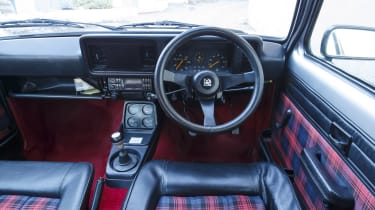evo Icons - Vauxhall Chevette 2300HS driven - Vauxhall Chevette 2300HS driven - page 2
A drive over the Route Napoleon in Southern France introduces us to one of Vauxhall's hidden historical gems
The appeal continues when inside. If any reminder were needed that Volkswagen’s Golf GTI far from monopolised the tartan trim market in the 1970s, the 2300’s cabin is it. Vibrant red and grey chequers grace the seat faces and doorcards. Sporting credentials are further justified by the red carpets and deep-dish three-spoke steering wheel, and while the instrument panel seems under-nourished with just a speedometer, tacho and clock, a quartet of gauges low in the centre console are further pub ammo for the contemporary rally enthusiast.
The driving position is surprisingly civil. The seat is soft and better-shaped than it initially appears, and while the wheel is offset – not just positioned slightly to the left, but also angled towards your right shoulder – the small-diameter rim and deep dish leave it in a suitable position for comfort and leverage.
Pedal placement isn’t ideal for heel-and-toe gearchanges, with the throttle set a little too far to the right and a little too high. There’s nowhere to put your left foot either, a wide transmission tunnel occupying the space required for a dead pedal.
Pull out the choke, prod the throttle a couple of times to prime the carbs, twist the spindly key and the slant four chunters into life with a lumpy idle. It’s lumpier still at elevation in the Alps; the Strombergs seem unhappy breathing in the thinner air.
That’s initially the case on the road, too. With a self-imposed 4500rpm limit - out of deference to the car’s age - the full extent of the Chevette’s performance is left un-tapped, but things still feel oddly flat at first. There’s certainly not the eagerness hinted at in contemporary road tests or the torque you’d expect from a large-capacity four in a 1014kg body.
Accessing the performance is a physical affair. Not just in the unassisted steering, which is expectedly heavy through its small rim and wide tyres – if beautifully direct – but also the throttle pedal, which requires almost as much effort to press as the brake and contributes to the big 2.3’s surprisingly lazy feel.
Closer to sea level, and utilising a few more revs, the HS finally comes alive. Gulping thicker air, the 2.3’s low-down torque becomes apparent, and beyond 4000rpm the engine note changes from a gruff growl to a blaring bark. The Getrag ‘box with its dogleg first – initially obstinate – begins to cooperate as the needle climbs the tachometer, slotting cleanly along the second-to-third plane. The clutch is light too, and at lower speeds the torquey lump up front means it’s as tractable at lower speeds as it is at higher ones.





